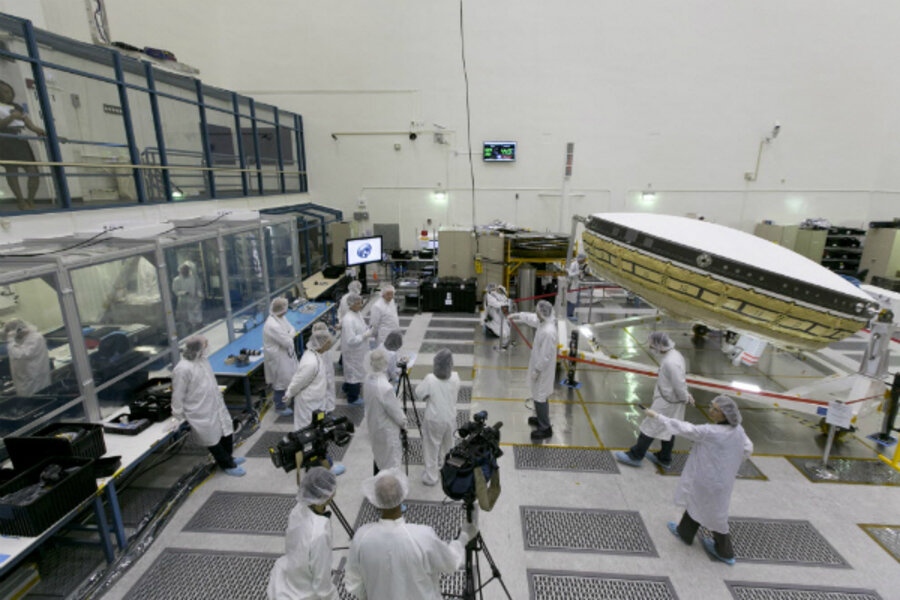How can NASA put a two-story building on Mars? Its very own flying saucer.
Loading...
| PASADENA, CALIF.
The Jet Propulsion Laboratory here – one of NASA’S leading research and development centers – gave journalists a peek at the future Wednesday. Get out your notebooks and scratch out the words, “flying saucer” and put in, “Low-Density Supersonic Decelerator” (LDSD).
That’s what they’re calling the new, rocket-powered, saucer-shaped test vehicle they will be propelling into near-space this June from the US Navy’s Pacific Missile Range Facility on Kauai, Hawaii. The purpose: to investigate how to land on Mars with bigger payloads.
NASA's LDSD aims to to slow down the descent of a large payload at supersonic speeds through the thin atmosphere of a planet like Mars by creating atmospheric drag.
Looking almost exactly like a miniature version of the spaceship that beguiled Richard Dreyfus in 1977’s “Close Encounters of the Third Kind,” the new LDSD is propped up on a special, multipronged trailer in the five-story room where it was assembled here. The press had to don surgeon hats, booties, and special outerwear to get close, while scientists explained the advancing needs of exploring Mars.
The new saucer, er, LDSD, is about 6 feet high and 22 feet in diameter.
“We expect that as we go forward with our Mars missions that we will go to larger and larger vehicles,” said Mark Adler, NASA’s LDSD demonstration mission manager. He says the current technology for landing in non-Earth atmospheres dates back to NASA’s Viking program, which put two landers on Mars in 1976. The same, basic parachute design has been used ever since – as recently as 2012 to deposit the Curiosity rover on the Red Planet.
But to conduct ever-more-sophisticated exploratory missions in the future, NASA will likely want to land much heavier spacecraft, so it is having to advance its technology for heavier payloads.
The Sojourner rover, which was the Mars Pathfinder mobile robot that landed on July 4, 1997, was a microwave-sized vehicle that weighed about 24 pounds. NASA then moved to two Exploration rovers in 2003, each about 400 pounds, and then to the Curiosity rover in 2012, which is about the size of a Mini Cooper auto. But the rocket thrusters that helped land the Curiosity rover don't work for larger payloads.
The LDSD program represents the next big step.
“Especially if we are going to land humans on Mars some day, we will get to much, much, much larger payloads, and we’ll need much larger decelerators to slow them down,” said Mr. Adler. The future could include landing two-story structures as big as a house or small building.
The media were shown a video depicting new experiments using rockets and pulleys created to test ever-larger parachutes, which have outgrown the wind tunnels that, until now, have served the purpose. Some of those tests have occurred at the China Lake Naval Air Weapons Station in California, beginning in 2012.
The next level of tests is scheduled for June through 2015 at the Pacific Missile Range Facility. A giant balloon developed at NASA’s Wallops Flight Facility on Wallops Island, Va., and the Columbia Scientific Balloon Facility in Palestine, Texas, will lift the saucer-shaped vehicle to about 120,000 feet (23 miles). The very thin air in Earth’s stratosphere simulates that low-density atmosphere of Mars.
Then the cargo device will be rocket-propelled to reach speeds up to four times the speed of sound, simulating the speeds payloads will be traveling through the atmosphere of a planet like Mars.
Here's how the decelerator works: NASA's new design borrows from the Hawaiian puffer fish, the o’opu hue, which increases size without adding mass. At supersonic speeds too strong for a parachute, a donut-shaped decelerator attached to the outer rim of a capsule-shaped entry vehicle inflates, slowing the descent to the point where a larger parachute can deploy, allowing the capsule to land safely.
“We want to land them at altitudes that we haven’t been able to explore new regions of Mars,” says Ian Clark, LDSD’s principal investigator. “To be able to land them more accurately, and to be to be able to focus on the explorations, we need new technologies – not just for the science we have, but for the long-term vision of eventually putting humans on the surface of Mars.”







